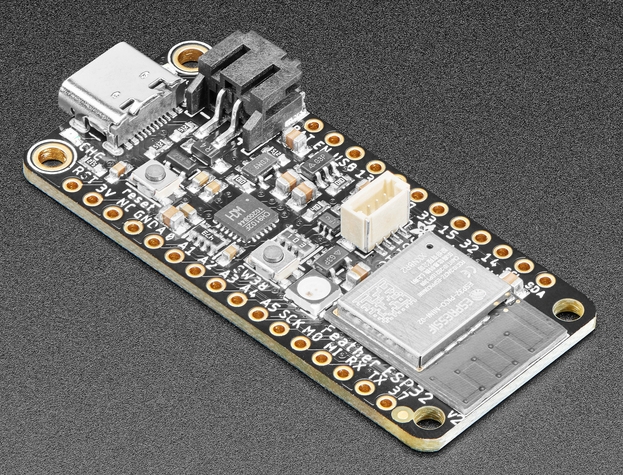
I ordered yet another ESP32 based board to experiment with. The latest in my collection is the Adafruit ESP32 Feather V2. You can learn quite a bit here: https://learn.adafruit.com/adafruit-esp32-feather-v2 . I have it programmed with the standard MicroPython v1.18 release from here: https://micropython.org/download/esp32/ . By the way, when you read the instructions on that page on how to program the Feather, you want to use the latest official release which is currently 17 January 2022, or esp32-20220117-v1.18.bin. The directions are correct, just make sure to use the most current MicroPython version.
I’m happy to have this board, as it’s the only board that I have the official MicroPython (v1.18) release running on. All my other ESP32 boards require a nightly to run, including Adafruit’s own QT Py ESP32-C3 board, which I touched on in an earlier post.
import machine as maimport neopixel as neoimport time as tiimport osprint(', '.join(os.uname()))import platformprint(platform.platform())import espprint("Flash size {} in bytes".format(esp.flash_size()))name = os.uname()[-1].split(' ')[-1]if name is 'ESP32S3':# For the Espressif ESP32-S3-DevKitC-1-*#pinnum = 48elif name is 'ESP32':# Setup specifically for Adafruit Huzzah ESP32 V2.# Pin 0 is the data pin to the NeoPixel,# Pin 2 is the power pin that must be set as an# an output and on, or high.#pinnum = 0## Turn on the power for the NeoPixel.#pwr = ma.Pin(2, ma.Pin.OUT)pwr.value(1)else:# For the Adafruit QT Py ESP32-C3 WiFi Dev Board#pinnum = 2np = neo.NeoPixel(ma.Pin(pinnum), 1)neopixel_colors = [(64, 0, 0), # red(0, 64, 0), # green(0, 0, 64), # blue(0, 64, 64), # cyan(64, 0, 64), # magenta(64, 32, 0), # yellow(0, 0, 0)# black]while(True):for color in neopixel_colors:np[0] = colornp.write()ti.sleep_ms(750)np[0] = neopixel_colors[-1]np.write()ti.sleep_ms(250)Because there are no common “magic” names for the NeoPixel pin, I’ve had to resort to testing what ESP board I’m running on and setting up the pin number accordingly. For the ESP32 Huzzah, I’ve also had to do a bit more work, specifically turning power on to the NeoPixel. This is covered in the Adafruit documentation linked to above. The section for handling the Huzzah’s NeoPixel sets the right pin to communicate with the NeoPixel as well as enable the power for the NeoPixel. And if you read the Adafruit documentation, you’re going to have to turn on the power pin if you want to use the I2C bus. The NeoPixel and I2C bus are both powered from the same pin so that if you need to shut down completely, you can do so programmatically before going into very deep sleep.
One other observation about this board. Adafruit says that the new USB adapter chip requires a driver for macOS. I’ve tried this on an M1 MacBook Pro with Monterey 12.4 and it shows up just fine. So if you have a contemporary Mac with any version of Monterey (which at least may include Big Sur, version 11) DO NOT install that driver they offer. I can’t speak to Windows, but I’d be very surprised if Windows 10 needs a driver. If you get one of these boards, plug it in and look to see if it comes up first before blindly installing any software drivers.

You must be logged in to post a comment.